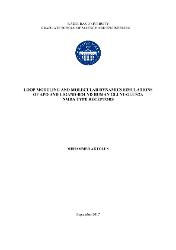Loop modeling and molecular dynamics simulations of apo and ligand-bound human glun1-hlun2A nmda type receptors
| dc.contributor.advisor | Eşsiz, Şebnem | en_US |
| dc.contributor.author | Aktolun, Muhammed | |
| dc.date.accessioned | 2019-07-12T08:37:28Z | en_US |
| dc.date.available | 2019-07-12T08:37:28Z | en_US |
| dc.date.issued | 2017 | en_US |
| dc.identifier.uri | https://hdl.handle.net/20.500.12469/2147 | |
| dc.description.abstract | N-Methyl-D-Aspartate receptors (NMDARs) are glutamate-gated ion channels found in the nerve cell membranes. The functioning of the receptor is of crucial importance in consciousness and normal brain functions. As a result of overexcitation of NMDARs neuronal death occurs and may lead to diseases such as epilepsy stroke Alzheimer's and Parkinson's. Understanding the molecular mechanism and structure function relationships of the receptor might lead to discovery of new drug target mechanisms. Recently there are two intact X-ray structures available one is from Xenopus laevis and the other one is from Rattus norvegicus for GluN1-GluN2B type NMDA receptor. First both Xray structures are examined and compared for the ion channel especially by taking the general problems into consideration which arise from crystallization conditions. Human GluN1- GluN2A type NMDAR structure is modeled based on the structure of Xenopus laevis template and missing loops are added by ab-initio loop modeling. Final structure is chosen according to the model assessment scoring function. NMDAR activation requires binding of two coagonists glycine and glutamate. To be able to observe the structural changes upon ligand binding glycine and glutamate molecules are docked into the corresponding binding sites of the receptor. Subsequently Molecular Dynamics (MD) simulations of 1 microsecond are performed for both apo and ligand-bound structures. 10 structural parameters which have been considered as functionally important in previous NMDA studies are developed to understand the dynamics of the conformational changes that is associated with the function of the protein throughout the simulations. Moreover Principal Component Analysis is performed for the equilibrated part of the simulations to classify similar conformations together. in the ligand-bound simulation certain loop regions showed higher mobility. Upon ligand binding closure in LBD clamshell smaller ATD-LBD inter-domain distance and larger LBDTMD linker distance is observed in specific subunits. Opening in the bottom TMD girdle is observed for a short time. Correlated motions of the receptor in the ligand-bound simulation increased. The structure showed rotation-like motion in the apo simulation whereas slidinglike motion within the neighboring heterodimers are observed. | en_US |
| dc.description.abstract | N-Metil-D-Aspartat (NMDA) reseptörleri sinir hücrelerinin zarında bulunan glutamat-kapılı iyon kanallarıdır. Reseptörün fonksiyon göstermesi, bilinçlilik ve normal beyin işlevlerinde büyük öneme sahiptir. NMDA reseptörlerinin aşırı uyarılması sonucu, nöronal hücre ölümü oluşur ve bunun sonucunda epilepsi, inme, Alzheimer ve Parkinson gibi hastalıklar ortaya çıkar. Reseptörün moleküler mekanizmasını ve yapı-fonksiyonu ilişkilerini anlamak, yeni ilaç geliştirme mekanizmalarının keşfedilmesini sağlayacaktır. Yakın zamanda, GluN1-GluN2B reseptörü için iki yeni bütün X-ışını yapısı, biri Xenopus laevis'ten, diğeri Rattus norvegicus'tan olmak üzere, elde edilmiştir. İki yapı zar proteinlerinin yapılarını kristalize ederken ortaya çıkan genel problemler göz önüne alınarak analiz edilmiş ve karşılaştırılmıştır. İnsan GluN1-GluN2A tipi NMDAR yapısı, Xenopus laevis şablon yapısına dayalı olarak modellenmiştir ve eksik döngüler ab-initio döngü modellemesi ile eklenmiştir. Son yapı, model değerlendirme ve puanlama fonksiyonuna göre seçilmiştir. NMDAR aktivasyonu için, glisin ve glutamat olmak üzere iki agonistin aynı anda yapıya bağlanması gereklidir. Ligand bağlandığında yapısal değişiklikleri gözlemleyebilmek için, glisin ve glutamat molekülleri reseptörün ilgili bağlama bölgelerine "dock" edilmiştir. Sonra hem apo hem de ligand bağlı yapılar için 1 mikrosaniyelik Moleküler Dinamik (MD) simülasyonları uygulanmıştır. Önceki NMDA çalışmalarında fonksiyonel olarak önemli olduğu tespit edilen 10 yapısal parametre, simülasyonlar boyunca yapısal değişikliklerin dinamiklerini anlamak için incelenmiştir. Ayrıca, benzer hareketleri birlikte sınıflandırmak amacıyla simülasyonların dengelenmiş kısmı için "Principal Component Analysis" gerçekleştirilmiştir. Ligand bağlı simülasyonda, bazı döngü bölgeleri daha yüksek mobilite göstermiştir. Ligand bağlandığında, belli zincirlerde, LBD deniz kabuğunda kapanma, daha küçük ATD-LBD mesafesi ve daha büyük LBD-TMD "linker" mesafesi gözlemlenmiştir. Alttaki TMD girdle'ın açılması kısa bir süre için gözlemlenmiştir. Reseptörün korelasyonlu hareketleri ligand bağlı simülasyonda artmıştır. Yapı, apo simülasyonunda rotasyon benzeri bir hareket gösterirken yan yana duran heterodimerler arasında kayma benzeri hareket gözlemlenmiştir. | en_US |
| dc.language.iso | eng | en_US |
| dc.publisher | Kadir Has Üniversitesi | en_US |
| dc.rights | info:eu-repo/semantics/openAccess | en_US |
| dc.subject | Biyofizik | en_US |
| dc.title | Loop modeling and molecular dynamics simulations of apo and ligand-bound human glun1-hlun2A nmda type receptors | en_US |
| dc.type | masterThesis | en_US |
| dc.department | Enstitüler, Lisansüstü Eğitim Enstitüsü, Hesaplamalı Bilimler ve Mühendislik Ana Bilim Dalı | en_US |
| dc.relation.publicationcategory | Tez | en_US |
| dc.identifier.yoktezid | 478376 | en_US |
Files in this item
This item appears in the following Collection(s)
-
Tez Koleksiyonu [1348]
Thesis Collection
















